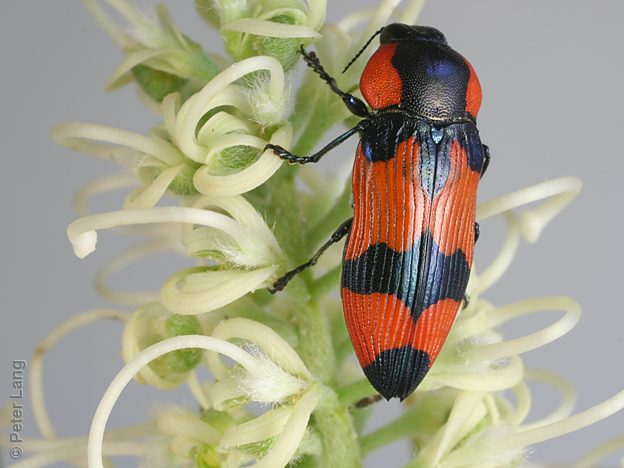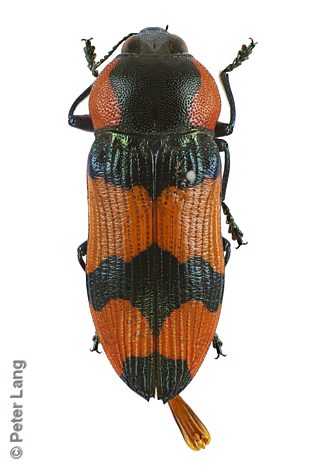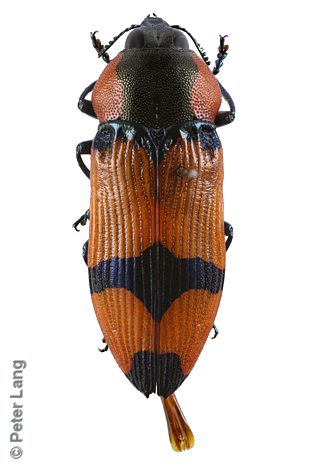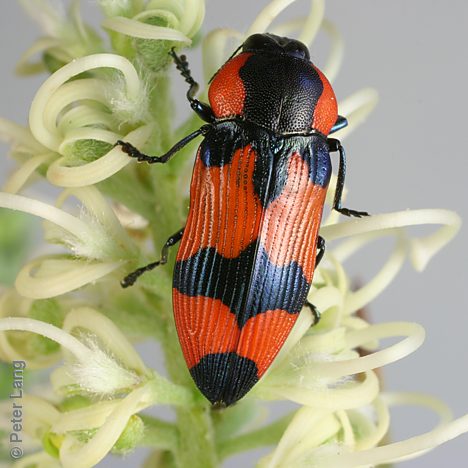



Actual
size¹:
size¹:
13.6 mm
×
4.9 mm
×
4.9 mm




| male | female | |||||
|---|---|---|---|---|---|---|
| L1 | 13.2 | 10.5 – 15.1 | n = 14 | 14.5 | 12.2 – 15.9 | n = 6 |
| L2 | 13.1 | 10.1 – 14.8 | n = 11 | 14.0 | 11.65 – 15.55 | n = 6 |
| W | 4.7 | 3.7 – 5.5 | n = 14 | 5.3 | 4.3 – 6 | n = 6 |
| Legend | L1 | length from clypeus/frons to elytral apex (mean, range, sample size) |
| L2 | length from anterior of edge of eyes to elytral apex | |
| W | maximum width with elytra fully closed |
| Legend | P.J.Lang collection vouchered records | |
| other private collection or museum specimens, or sightings |
|
|
|
|
|
|
|
|
|
|
|
|
|
||||||||||||||||||||||||||||||||||||||||||||||||
|
|
|
|
|
|
|
|
|
|
|
|
|
||||||||||||||||||||||||||||||||||||||||||||||||
| Jul | Aug | Sep | Oct | Nov | Dec | Jan | Feb | Mar | Apr | May | Jun |
| Legend | ||
9 | number of active beetles, actually recorded in that quarter-month | |
| actual count > 7 (median) | ||
| actual count <= 7 (median) | ||
| beetles | sites | SA regions¹ | family | position on host plant | ||||
| Grevillea pterosperma | 30 | 5 | EP | P1 | ||||
| Bursaria spinosa ssp. spinosa | 13 | 1 | EP | P2 | ||||
| Myoporum platycarpum ssp. perbellum | 9 | 1 | EP | S | ||||
| Leptospermum coriaceum | 6 | 5 | EP | M | ||||
| Melaleuca pauperiflora ssp. mutica | 3 | 2 | EP | M | ||||
| Acacia euthycarpa | 1 | 1 | EP | F | ||||
| Eucalyptus socialis | 1 | 1 | EP | M | ||||
| Eucalyptus socialis ssp. socialis | 1 | 1 | EP | M |
| Legend | beetles | count of beetles collected from, or sighted on, host plant taxon |
| sites | count of major sites (unique 10 km grid cells +/- some distinct approximate localities) | |
| Plant names in green are hyperlinked to a matching host species page with plant photos. | ||
| Code | beetles | % | host plant taxa | |
| P1 | Proteaceae | 30 | 47% | 1 |
| P2 | Pittosporaceae | 13 | 20% | 1 |
| M | Myrtaceae | 11 | 17% | 4 |
| S | Scrophulariaceae | 9 | 14% | 1 |
| F | Fabaceae | 1 | 2% | 1 |
| position | beetles | sites | |
| on flower(s) | 38 | 6 | |
| on flowering plant | 8 | 4 | |
| on plant (unspecified) | 18 | 5 |
In SA, adults have been found on a range of plants that have nectar-rich white (to cream) flowers, with Grevillea pterosperma, Bursaria spinosa and Myoporum platycarpum being the three most frequently recorded hosts. In the Birchup district of north-western Victoria Goudie 1920 stated that it 'used to be fairly common' and that he had only taken it on 'dogwood' blossoms. This most likely refers to Myoporum platycarpum (and is supported by his brief description of it in reference to some Neocuris species).
| ¹ Legend | regions | SA State Herbarium regions (map) EA: Eastern, EP: Eyre Peninsula, FR: Flinders Ranges, GT: Gairdner-Torrens, KI: Kangaroo Island, LE: Lake Eyre, MU: Murray, NL: Northern Lofty, NU: Nullarbor, NW: North-Western, SE: South-Eastern, SL: Southern Lofty, YP: Yorke Peninsula |
| size | The ellipse is the correct size when printed, indicative on a desktop screen, and likely to be wrong on a mobile device. |